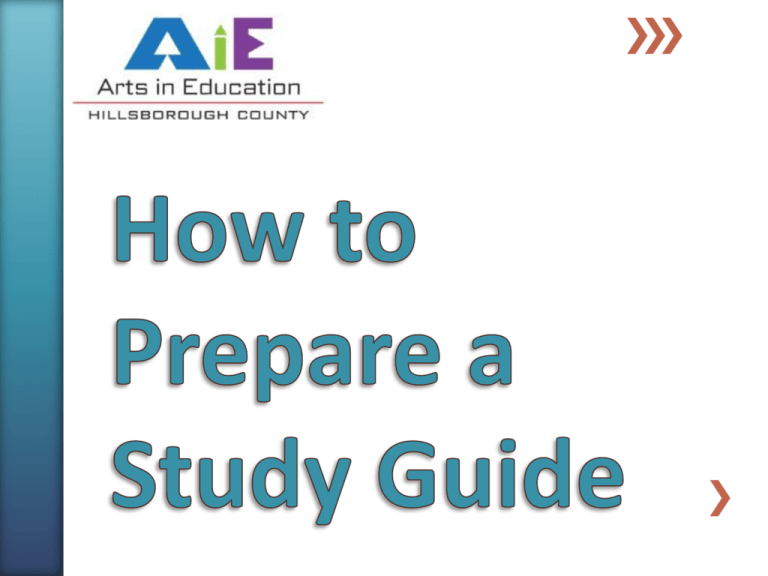How to Prepare a Study Guide Powerpoint
advertisement

This training program is a collaborative project of the Arts Council of Hillsborough County, Katie Adams’ Make Believe Theatre and VSA – Florida and is sponsored in part by the State of Florida, Department of State, Division of Cultural Affairs and the Florida Council on Arts and Culture. Why do I need a study guide? » The purpose of a study guide is to provide teachers with the tools to prepare their students for the performance or workshop that they will experience and provide a direct connection to curriculum through activities that address the Florida Standards. » Title and description of program » Bibliography/Discography » Information relating to performance/workshop genre and content. » Additional information relating directly to your program. » Theatre/Workshop Etiquette » Pre & Post activities teachers can do in the classroom with their students. » Standards and benchmarks addressed by these activities. » Bio for artist(s) or company. » Required credit line Title and description of program » The description should include what teachers can expect to see and what will happen – the content of the program. This can include things like, a story synopsis, list of musical selections to be played, list/describe characters or artists in the performance, etc. » Think about what the students will know and be able to do after they have experienced the performance or workshop. Identify which standards are connected to the performance/workshop experience. Information relating to performance/workshop genre and content. » This would include historical/cultural background needed to understand the performance or workshop content. Include information about the author, composer, artists, etc. Theatre/Workshop Etiquette » This would be an explanation of appropriate behavior during the performance or workshop. Identify the Theatre standards pertaining to etiquette. Pre & Post activities teachers can do in the classroom with their students. » Activities should provide for reading, writing, speaking and listening. » Pre activities should prepare students for what they will experience. Think about what they need to know to understand the performance or workshop. What events, sounds, etc. should the audience look for in the performance? What contributes to the creation of your artwork? » Post activities should expand and reinforce the performance or workshop experience. What was the turning point in the action? What instruments were used? What contributed to the creation of the artwork? Pre & Post activities teachers can do in the classroom with their students. » Activities should allow the students to experience the art form. For example - act out a scene, practice movement and use of time, space, energy, rhythm, make "found" instruments, paint a vase in the "Red Figure" style » Supplies or materials used in pre & post activities should be things that teachers are likely to have in the classroom. Standards and benchmarks addressed by these activities. » Standards and benchmarks outline what students should know and be able to do after completing activities and experiencing your performance or workshop. You are the expert regarding your performance or workshop and are the most qualified to identify what knowledge/skills will be gained. Teachers must align all student experiences with the curriculum so this is a critical piece of any study guide. Standards and benchmarks addressed by these activities. » Specific standards must be identified for each activity as opposed to a “laundry list” of overall standards that apply. » When identifying standards, start with your primary art form Dance, Theatre, Music, Visual Art. You do not need to include every possible standard - one standard per applicable grade level is fine. » Next, identify non-arts connections. This should be natural connections and not forced. For example, Language Arts standards naturally connect to theatre performance, storytelling, opera, etc. Bibliography/Discography » When writing a bibliography, remember that the purpose is to communicate to the reader, in a standardized manner, the sources that you have used in sufficient detail to be identified. » Include a comprehensive list of musical selections if applicable. » Include a glossary of terms or vocabulary list. » Include a list of additional resources if applicable. Additional information relating directly to your program. » For example pictures, lyrics of songs performed, important stories, historical or geographical information, costuming information, from page to stage, information on dancer’s shoe, etc. Bio for artist(s) or company » Write a brief biography to introduce yourself, fellow artists or company. Highlight achievements, list credentials and any notable projects with which you are involved. Bios should be short and concise, listing only relevant information. Avoid listing personal statistics, such as family and hobbies. Include required credit line » "This program is presented as part of the Artists-in-theSchools Program, which is funded and jointly sponsored by the Hillsborough County Public Schools and the Arts Council of Hillsborough County."





